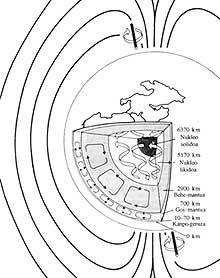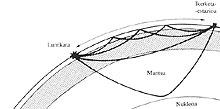What is the heart of the Earth?

As we all know, the Earth is round, or rather, almost round and almost circular, it is precisely what engages scientists. Because under the soil we tread we produce phenomena that cause volcanoes, continental displacements, earthquakes, magnetic fields, etc. These phenomena and movements alter the internal structure of the Earth and cause on the surface mountains and valleys. Irregularities in the deep layers appear in the subsoil.
It is surprising to want to express the inner structure of the earth and its irregularities, to know what is inside an uncut apple.
One fact to take into account is that the deepest hole made so far by humans is in the Soviet Union (Murmansk) and has twelve kilometers (the land surface is 6,380 kilometers from the center). By 2000, another 14,000 metre hole is expected to be built in German Bavaria. In the drilling to be performed, up to 6,000 meters will be used conventional tools to extract oil.
From there a special engine is released, specially designed. The motor itself will be at the depth of the hole by actuating the diamond head at the same time that the deviations of the shaft of the hole will be constantly corrected. This material must withstand a temperature of 300°C and a pressure of 4,000 atmospheres, conditions that distance 14 km.
And if there are those difficulties to delve 14 kilometers, it depends on what it is to reach the center of the Earth. But today it is possible to study the heart of the Earth without going. To do this, scientists use seismography, just as doctors use X-ray and ultrasound to analyze the inside of the body. When there is an earthquake, mechanical waves, similar to sound waves, can be recorded remotely in a device called a seismograph. The study of the arrival of these waves to the seismography allows us to know the underground structures. In this way it has been possible to know the existence of different layers in the subsoil.
In the center of the Earth there is a solid core and around it a liquid core (see figure). Then comes the mantle, divided into two parts: low robes and upper robes. Both sides present a different chemical composition or crystalline state, although not yet known accurately. Finally there is the outer layer or crust.
These underground layers have been found for years. For example, in 1906 a liquid nucleus was discovered, and in 1936 the Danish Inge Lehmann discovered that there was a solid nucleus.
If the Earth were paralyzed in space and had reached its equilibrium state, these inner layers would be perfectly spherical, with the heavier materials inside and the lighter ones outside.
However, the Earth revolves around its north-south axis, making it somewhat more crushed at the poles and fatter at the equator. This not only occurs in the outer layer, but also occurs in the mantle and core. Furthermore, the Earth moves in space and does not get its balance. Therefore, the internal movement generates irregularities. These internal irregularities indicate the "life" of the Earth and have been recently measured. If the measurements of the planet are taken into account, the internal irregularities are not large, 10 to 12 kilometers high. The nucleus, for example, presents an irregularity (non-spherical) in the South Atlantic and has recently been discovered why satellites descend as they pass to that pair.
In 1984, seismologists were able to fully understand the shape of the mantle, and now decide what the shape of the core is.
The truth is that the discoveries have happened. Early research used waves that spread near the earth's surface. Then extended waves have been used to capture the mantle and core. Thanks to this, they have discovered that solid matter moves in the mantle. Only the perfect solid is indeformable and in the basement there is no perfect solid. Like liquids, but at a much lower speed, solids also flow or flow, just like glaciers.

In the underground mantle, solid matter presents convective movements at low speed, just like water before boiling in a container. Hot water (hot part of the mantle in our case) rises and cold (cold mantle) falls. The warm mantle rises in front of the territories where volcanoes are located and compress the central plates of the oceans, strengthening the continents. In intercontinental areas the mantle is colder and lower.
The data provided by seismology have allowed us to certify theories about continental displacements. The continents are on the mantle and are affected by their convective movements, often oblique and not vertical.
The core starts at about 2,900 kilometers deep and the pressure and temperature make the composition and condition of the material different. Iron is liquid at this point. The boundary between the mantle and the liquid core is not at all spherical. Irregularities are ten to twelve kilometers.
In addition, large swirls occur in the liquid nucleus that seem to be related to the Earth's magnetic field.
The solid iron core is finally much more deformed. On the sides of the pole the radius is 100 kilometers higher than the equator, and that is much, of course, when the average radius of the solid core is 500 kilometers. Therefore, the heart of the Earth resembles Rugby.
However, some scientists are doubtful. How can it be stable? Have seismologists not registered this form because the crystals of the nucleus are anisotropes? (In anisotropic crystal the waves spread faster in one direction).
These and many other questions are still many to answer, so that we know in detail how the heart of the Earth is. However, the heart of the Earth is not that of lakes, seas, giant fungi and dinosaurs as described by Jules Verne in his novel, but living matter unbalanced and full of movement.
Buletina
Bidali zure helbide elektronikoa eta jaso asteroko buletina zure sarrera-ontzian











